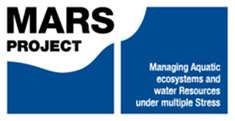Physical alteration of channel, bed, riparian area, shore of water body
Humans have altered the course, shape and character of water bodies in Europe for centuries, in order to make water available for the development of urban areas, agriculture and the production of energy, and to provide protection from flooding and drought. Physical alterations of the channel, riparian and surrounding floodplain and wetland areas of water bodies are known as hydromorphological pressures, in that they alter both hydrology (i.e. water flow dynamics) and morphology (i.e. the physical structure). Physical alteration pressures can cause significant changes to the state of aquatic environments, and have impacts such as loss of biodiversity habitat and increased risk of severe flooding and drought (EEA 2012).
Pressure types
There are a number of physical alteration pressures generated by different drivers:
Urban development
Urban development of river channels - waterways have often been historical catalysts for urban growth, and as a result many European rivers and their flood-plains have been encased in concrete in the last century as urban areas have grown, often straightening and narrowing water flows within fixed, manageable courses, or in some cases, burying them underground into sewer networks.
Flood protection - many rivers have been physically altered in order to manage the impact of high water flows and minimise flood damage through the construction of flood walls and dykes and the straightening and reinforcement of river beds and channels. This often changes the dynamics of flow regimes through the aquatic ecosystem, decreases habitat diversity, and decouples the river channel from its wider flood-plain.
Alteration of transitional waters - the shorelines of many transitional and coastal waters in Europe have been widely modified in the last century, for example through dredging and land reclamation for construction of ports, harbours and navigation, for flood protection, freshwater supply and beach development.
Agriculture
Alteration of water bodies - in many parts of lowland Europe streams in agricultural areas have been straightened, deepened and widened to improve land drainage and to prevent flooding.
Removal of riparian vegetation - agricultural intensification across the continent has meant that many areas of riparian vegetation along the banks of rivers and lakes have been removed, increasing the potential for bank erosion (particularly where grazing animals are involved), removing habitats for biodiversity and reducing the capacity for vegetation to buffer diffuse pollutants.
Forestry
Construction of drainage ditches and channels - commercial forestry practices often involve the alteration of existing water bodies to facilitate irrigation and drainage.
Transport
The creation of navigable waterways - large container ships and ferries require deep and open waterways and harbour areas, which means that many large rivers and their connection to marine waters in Europe have been dredged, straightened and/or widened in order to facilitate navigation.
Industry
Mineral extraction - gravel and sand have been extracted from numerous European river basins in the last century, resulting in widespread channel alterations and incisions.
Geographical distributions and trends
Hydromorphological pressures (including dams, barriers and locks and hydrological alteration) are most prevalent in inland water bodies in Northern, Western and Eastern Europe, with more than 90% of water bodies in areas of Northern Germany, The Netherlands and Northern France affected by such pressures (EEA 2012). Hydromorphological pressures in transitional waters are also high along the same North Sea coast of continental Europe, and around the southern Mediterranean coast of Italy (EEA 2012).
Stressors generated
The key stressors generated by physical alteration pressures are morphological (i.e alterations to the shape, course and shoreline of a water body) and hydrological (i.e. alterations to the quantity, flows and timings of water dynamics in a water body, inundation frequency and duration of riparian zones and floodplains). Alterations to the riparian areas around a water body may reduce the natural capacity to buffer pollutants, and so increase the prevalence of chemical stressors.
Potential for mitigation
Mitigation strategies for physical alteration pressures are often undertaken as ‘restoration’ projects, and include: the removal of bank and bed enforcements such as flood walls; the restoration of bank and bed structures and habitats (e.g. gravel beds for fish spawning and nursery areas); the reconnection of meander bends and side channels; enlarging space in the landscape for periodical inundation of flood plains; the replanting and/or fencing of riparian vegetation along river channels; and the ‘daylighting’ of water courses buried underground in urban developments (EEA 2012). Water body restoration is still a relatively new practice – increasingly common in the last 20 years – and the long-term ecological effects of many restoration measures are still being monitored, for example as shown in the EU REFORM project.
Further reading
Reports and publications:
EEA (2012). European waters - assessment of status and pressures (Download report, 28mb)
Other websites:
REFORM (2015). Overview of river restoration measures (External website)
REFORM (2015). Alteration of riparian vegetation (External website)
REFORM (2015). Remove bank fixation (External website)
Selected Freshwater blogs:
Freshwaterblog (2015). What influences the ecological success of river restoration? (External website)
Freshwaterblog (2016). Conservation and restoration of riparian zones under multiple pressures (External website)
Freshwaterblog (2017). Restoring Swindale Beck (External website)



